Objectives
1. 🎯 Understand and apply the average speed formula in uniformly varied motion.
2. 🎯 Calculate the average speed in different real-life scenarios, using data on initial and final speeds effectively.
Contextualization
Did you know that the idea of average speed plays a vital role in our daily lives? Whether you’re gauging the time needed for your daily commute in a bustling city like Mumbai or analysing the performance of a racer on a track, the concept of average speed comes in handy. For instance, imagine watching a Formula 1 race or even tracking the pace of an auto-rickshaw in traffic—you can use average speed to objectively assess how steadily a driver is moving.
Important Topics
Average Speed Formula
The formula for calculating average speed in uniformly varied motion is key to determining how fast an object covers a distance over time. It subtracts the initial speed from the final speed and divides the result by the time taken. Mathematically, it is expressed as: VM = (Vf - Vi) / t, where VM is the average speed, Vf is the final speed, Vi is the initial speed, and t is the time period.
-
Initial Speed (Vi): The speed at which an object starts moving.
-
Final Speed (Vf): The speed at which the object ends its motion.
-
Time (t): The interval during which the speeds are recorded.
Uniformly Varied Motion (UVM)
Uniformly Varied Motion refers to a type of movement where the speed of an object increases or decreases at a steady, consistent rate. This principle helps us understand and apply the average speed formula clearly, as both initial and final speeds are crucial in describing uniformly varied motion.
-
Constant Acceleration: In UVM, the acceleration is constant, meaning the speed changes uniformly over time.
-
Time-Speed Graphs: These graphs depict motion in UVM, where the slope indicates the acceleration.
-
Practical Applications: Grasping UVM is essential for designing transportation systems, vehicle mechanics, and even planning travel.
Interpretation of Average Speed Problems
Being able to interpret and solve problems involving average speed is an important skill. It requires identifying the relevant information, applying the formula correctly, and deriving a result that is meaningful in real-life contexts.
-
Problem Contextualization: Ability to relate average speed concepts to everyday scenarios like calculating journey durations or distances covered on a local train or bus.
-
Equation Solving: Using the average speed formula to resolve equations involving various speeds and time intervals.
-
Understanding Limitations: Recognising situations where the average speed formula might not fully capture the dynamics, such as in erratic or non-uniform motions.
Key Terms
-
Average Speed: The ratio of the distance covered by an object to the time taken. In the context of UVM, it is often understood as the mean of the initial and final speeds.
-
Uniformly Varied Motion: A type of motion where the acceleration remains constant, leading to a steady change in speed.
-
Acceleration: A measure indicating how quickly the speed of an object changes over time. In UVM, this change occurs at a constant rate.
For Reflection
-
How does the concept of constant acceleration in UVM influence our understanding of motion in everyday life? Can you think of examples during your daily commute?
-
Why is it crucial to distinguish between average speed and instantaneous speed, especially in contexts like road traffic and sports?
-
In what way can solving average speed problems help in day-to-day decision making and planning, such as estimating travel time?
Important Conclusions
-
We reviewed the average speed formula and its application in uniformly varied motion, a concept essential for understanding everything from city commutes to sports events.
-
We delved into uniformly varied motion, highlighting the role of constant acceleration and how it is visually represented through graphs and calculations.
-
We discussed practical applications of these concepts in our daily lives, demonstrating how physics helps us make sense of everyday phenomena.
To Exercise Knowledge
- Create a travel log for a car trip: Note down the initial and final speeds for different segments and compute the average speed. 2. Draw a speed-time graph for an object accelerating at 4 m/s² for 5 seconds. 3. Calculate the average speed of a classmate walking across the classroom in 10 seconds, starting from rest (0 m/s).
Challenge
Park Challenge: Imagine you are designing a mini roller coaster. Plan the course so that the cart reaches various speeds and heights, then compute the average speed for each section. Try to optimise it to achieve the maximum possible average speed!
Study Tips
-
Practice with real-life examples: Apply the concept of average speed using scenarios like estimating the speed of a train between key stations.
-
Utilise visual tools: Sketch speed-time and displacement-time graphs to better understand the principles behind the average speed formula.
-
Study in groups: Collaborate with your peers to discuss different problems and share strategies for solving average speed scenarios.



